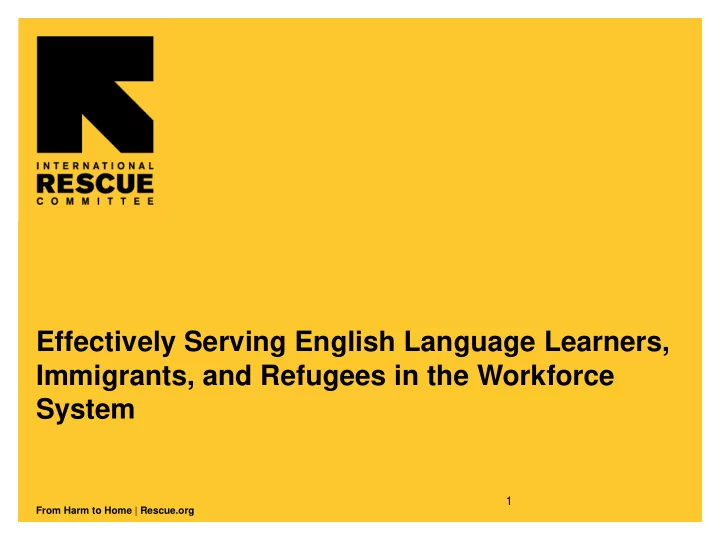

Effectively Serving English Language Learners, Immigrants, and Refugees in the Workforce System 1 From Harm to Home | Rescue.org
Agenda • New Americans and the Workforce • Historical Challenges • Why Now • Best Practices: ELL & Immigrant Adults • Best Practices: Immigrant Opportunity Youth • Building Partnerships to Maximize Success • Spotlight on Successful Programs 2 2 From Harm to Home | Rescue.org
New Americans • 15% of the U.S. population • 70% of working age adults in the workforce • 20% higher poverty rates • Median incomes that are 12% less than native-born 3 From Harm to Home | Rescue.org
Immigrants in California • 27% of our population – 10 million people – are foreign-born • 44% of households have a language other than English spoken at home 4 From Harm to Home | Rescue.org
Refugees Refugee Arrivals 2016 • 85,000 resettled in 2016 • California welcomed more than any other state • More than 90% speak English less than well • Authorized to work from day one 5 From Harm to Home | Rescue.org
Where are Immigrant and ELLs accessing employment services now? • Adult education programs • Community college • Community-based organizations • Faith-based organizations • Refugee-serving organizations • AJCs 6 From Harm to Home | Rescue.org
Why Now? • Demographics • WIOA • California’s investment of $2.5 million into ELL Career Navigator Pilot • Evidence-based models – it can be done 7 From Harm to Home | Rescue.org
Historical Challenges • Separation of language learning from job skills learning • WIOA outcomes and perception that ELL adults won’t meet them • Employer relations often not attuned to companies that have opportunities for ELL adults • Many steps to access services • These customers aren’t walking in the door to traditional workforce providers • Focus on COMPLIANCE in serving ELL adults not CREATIVITY in serving ELL adults 8 From Harm to Home | Rescue.org
Best Practices: ELL Adults • Community-based • AJC-based Navigators • Short-term ($) and long-term programming ($$) • Bilingual programs • Career pathways with bridge components • I-BEST approach to curriculum • Recertification Dos and Don’ts • Bundled services 9 From Harm to Home | Rescue.org
Best Practices: Opportunity Youth • Community-based • Meet youth where they are at in terms of education levels • GED/HiSET programming with hands-on instruction • Opportunities to explore careers • Stipends and incentives • Youth as outreach and liaison workers • Integrated behavioral health 10 From Harm to Home | Rescue.org
Building Partnerships to Maximize Success • Due diligence in figuring out which community partners have reach and capacity • Ask for outcomes – but understand what they mean and who was served • Use partnerships to foster integration of populations • Invite, invite, invite – CBOs are workforce implementers too! • Other systems • Understand what partners are funded to do, and what they aren’t 11 From Harm to Home | Rescue.org
Spotlight On: Health Professions Opportunity Grant • Federal grant to support careers in Allied Health • San Diego WIB included immigrant-serving organizations as funded partners • Flexibility to incorporate contextualized ESL and other responsive project components • Partnered with training providers • Project served ELL immigrants from more than 22 countries and achieved outcome goals 12 From Harm to Home | Rescue.org
Spotlight On: Hospitality Link • CBO-based program • Short-term, modular, contextualized learning • Direct job placement assistance • Credential incorporated for some participants • Opportunity to use OJT funds • Public/private partnership • In Year 1, 45% of clients were women, clients came from 20+ countries, 36% had primary education or less, and 89% had been in the U.S. less than two years 13 From Harm to Home | Rescue.org
Resources • Policy Brief: Serving English Language Learners (CA EDD) • Change 1 – Best Practices, Partnership Models, and Resources Available for Serving English Language Learners, Immigrants, Refugees, and New Americans • I-BEST • LINCS resources on ELLs and Career Pathways • Refugees and Workforce (ORR) 14 From Harm to Home | Rescue.org
Questions? 15 From Harm to Home | Rescue.org
Recommend
More recommend